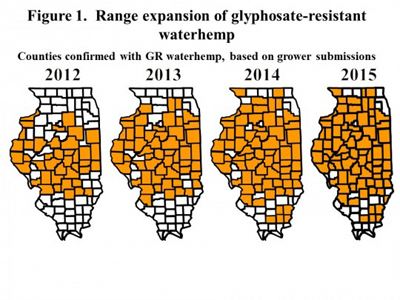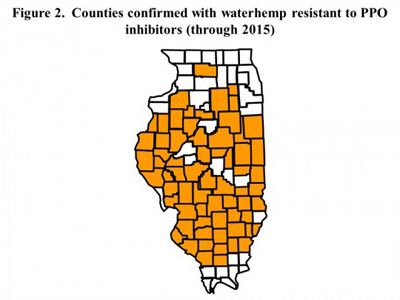Postemergence Options To Control Waterhemp In Soybean
DR. AARON HAGER
URBANA, ILL.
Waterhemp continues to be one of the most widespread and troublesome broadleaf weed species with which Illinois farmers must contend. Factors related to the species’ biology, such as prolonged germination and emergence, obligate outcrossing, and high seed production, contribute to management challenges. The evolution of herbicide resistance in Illinois waterhemp populations adds another very challenging obstacle for effective management. Recently, many have sent questions and concerns regarding the inability to control waterhemp with various postemergence soybean herbicides. A description of herbicide resistance in Illinois waterhemp populations, along with postemergence herbicide options to control waterhemp, follows.
Prior to the evolution of herbicide resistance in waterhemp, ALS-, PPO-, EPSPS- and GS-inhibiting herbicides controlled waterhemp postemergence in soybean. Resistance to ALS-inhibiting herbicides (such as Raptor and Classic), first confirmed in Illinois during the mid-1990s, has become so widespread that this class of herbicides is largely considered functionally ineffective against waterhemp. Resistance to PPO-inhibiting herbicides (such as Flexstar, Cobra, and Ultra Blazer) was first identified in Adams County in 2001, and the first instance of resistance to the EPSPS-inhibiting herbicide glyphosate (Roundup, etc.) was confirmed in Fayette County in 2006. To date, no instance of waterhemp resistance to the GS-inhibiting herbicide glufosinate (Liberty, Interline, Cheetah) has been reported.
Figure 1 shows the range expansion of glyphosate-resistant waterhemp from 2012–2015. These data are based on samples submitted to the University of Illinois for resistance verification with molecular marker assays. Figure 2, using the same data source as Figure 1, shows the current range of PPO-resistant waterhemp in Illinois. It should not be assumed that resistance does not occur in non-shaded counties; a better interpretation is simply that we have yet to test a positive sample from those counties. In other words, it is altogether likely resistance to glyphosate and PPO inhibitors occurs in all Illinois counties.
Waterhemp resistant to PPO-inhibiting herbicide can be controlled with glyphosate, and glyphosate-resistant waterhemp can be controlled by PPO-inhibiting herbicides. However, there are no effective herbicide options to control waterhemp resistant to both glyphosate and PPO inhibitors in conventional or glyphosate-resistant soybean varieties. As mentioned previously, ALS-inhibiting herbicides are ineffective, and 2,4-DB will not improve control. Inter-row cultivation or hand removal represent two options to control multiple-resistant waterhemp.
It remains very unlikely that a herbicide with a novel site of action will be commercialized in the foreseeable future. At the same time, the frequency of multiple resistant waterhemp will only increase. Many eagerly anticipate the ability to apply 2,4-D or dicamba to new herbicide-resistant soybean varieties, but the long-term utility of these herbicides to control multiple-resistant waterhemp will be compromised without thoughtful and implemented stewardship practices. ∆
DR. AARON HAGER: Associate Professor, University of Illinois

